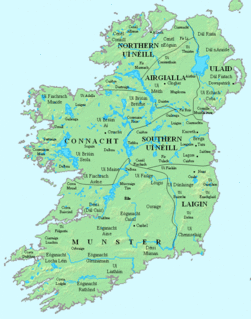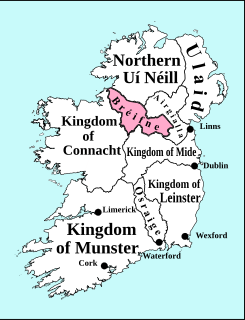Related Research Articles

Uí Fhiachrach Aidhne was a kingdom located in what is now the south of County Galway.

West Connacht was a kingdom of Gaelic Ireland, associated geographically with present-day County Galway, particularly the area known more commonly today as Connemara. The kingdom represented the core homeland of the Connachta's Uí Briúin Seóla kindred and although they ruled, there were smaller groups of other Gaels in the area, such as the Delbhna Tir Dha Locha and the Conmhaícne Mara. It existed from 1051 onwards, after the Ó Conchobhair, Kings of Connacht, pushed the Ó Flaithbheartaigh to the West of Lough Corrib, from their original territory of Maigh Seóla. Iar Connacht remained a subordinate túath of Connacht, until the 13th century, after which it was more independent.

Maigh Seóla, also known as Hy Briuin Seola, was the territory that included land along the east shore of Lough Corrib in County Galway, Ireland. It was bounded to the east by the Uí Maine vassal kingdom of Soghain and extended roughly from what is now Clarinbridge in the south to Knockmaa Hill in the north. Its rulers belonged to the Uí Briúin Seóla and are sometimes found in the annals under the title "King of Uí Briúin" and "King of South Connacht". The earliest identifiable kings belonged to the line that became the Clann Cosgraigh. However in later times the line which would become the Muintir Murchada, under the O'Flaherty chiefs, monopolized the kingship.

O'Flaherty, is an Irish Gaelic clan based most prominently in what is today County Galway. The clan name originated in the 10th century as a derivative of its founder Flaithbheartach mac Eimhin. They descend in the paternal line from the Connachta's Uí Briúin Seóla. They were originally kings of Maigh Seóla and Muintir Murchada and as members of the Uí Briúin were kinsmen of the Ó Conchubhair and Mac Diarmada amongst others. After their king Cathal mac Tigernán lost out to Áed in Gai Bernaig in the 11th century, the family were pushed further west to Iar Connacht, a territory associated with Connemara today. They continued to rule this land until the 16th century.
Uí Maine was the name of a kingdom situated in south Connacht, consisting of all of County Galway east of Athenry, all of southern and central County Roscommon.
Brian Luighneach Ua Conchobhair, Prince of Connacht, died 23 May 1181.

The Kingdom of Breifne or Bréifne was a medieval overkingdom in Gaelic Ireland. It comprised what is now County Leitrim, County Cavan and parts of neighbouring counties, and corresponds roughly to the Roman Catholic Diocese of Kilmore. It had emerged by the 10th century, as a confederation of túatha headed by an overking drawn from the Uí Briúin Bréifne.
Clan Sweeney is an Irish clan of Scottish origin. The Mac Suibhne family did not permanently settle in Ireland before the beginning of the 14th century, when they became Gallowglass soldiers for the Ua Domnaill dynasty of Tír Chonaill. The clan also claims an Irish descent from a prince of the Uí Néill dynasty, Ánrothán Ua Néill, son of Áed, son of Flaithbertach Ua Néill, King of Ailech and Cenél nEógain, died 1036. Through this descent the clan can claim a descent from Niall Noigíallach.

Muintir Murchada was the name of an Irish territory which derived its name from the ruling dynasty, who were in turn a branch of the Uí Briúin. The name was derived from Murchadh mac Maenach, King of Uí Briúin Seóla, who died 891.
Maelcairearda was King of Uí Briúin Seóla.
Donn mac Cumasgach was a king of Maigh Seóla who died in 752.
Máel Sechlain Mac Áeda was the Archbishop of Tuam 1312 – 10 August 1348.
Rúaidhri Ua Flaithbheartaigh was King of Iar Connacht.
Clann Cosgraigh was a branch of the Uí Briúin dynasty and also the name of the district on the eastern side of Lough Corrib, County Galway which they inhabited and ruled prior to the Norman invasion.
Murchad mac Flann mac Glethneachan was King of Maigh Seóla.
Ruaidhri Mac Aedha, Lord of Clann Cosgraigh, died 1170.
Donnchadh Ó Dubhda, King of Ui Fiachrach Muaidhe, fl. 1213.
Máelsechlain Mac Áeda was Lord of Clann Cosgraigh.
John na Mointech Mac Áeda, Chief of the Name, died 1582.
Tom McHugh, County Councillor and Mayor of County Galway 2009-10.
References
- ↑ O'Flaherty, Roderic (1684). A Chorographical Description of West or H-Iar Connaught (1846 ed.). pp. 362–363.
- ↑ O'Donovan, John (1856). Annals of the Kingdom of Ireland by the Four Masters from the Earliest Period to 1616, Vol. II. p. 1019.
- ↑ O'Hart, John (1881). Irish Pedigrees: Or, The Origin and Stem of the Irish Nation. p. 354.
- Medieval Ireland: Territorial, Political and Economic Divisions, Paul MacCotter, Four Courts Press, 2008. ISBN 978-1-84682-098-4
- http://www.rootsweb.ancestry.com/~irlkik/ihm/connacht.htm#aid
- http://celt.ucc.ie/publishd.html